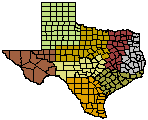- Trans Pecos
- High Plains/Panhandle
- Cross Timbers
- Hill Country
- Post Oak Savannah
- Pineywoods
- Oak Prairie
- South Texas Plains

Wildlife Division District Map
Pineywoods Wildlife Management
Habitat Management
Cow
Leopold often referred to the cow as a valuable management tool. Leopold realized that cows could be used to manipulate the habitat similar to the manipulation applied by herds of bison prior to their decline. Since much of the Pineywoods landscape has been converted to pasture, comprised of native vegetation (forbs and grasses) or improved grasses (coastal bermuda, bahia), cattle management in the Pineywoods affects wildlife populations. Pastures can be beneficial for a variety of wildlife species if properly managed. Native grass pastures will provide habitat for more species of wildlife than pastures dominated by tame grasses such as coastal bermuda or bahia. Since cattle primarily consume grass, they do not normally compete with most wildlife for the same food sources, unless forced to do so by excessive stocking rates and/or continuous grazing pressure. The main role of cattle grazing in a wildlife management program is to reduce the quantity of grass, allowing sunlight to reach the lower growing forbs. Many forbs are beneficial to wildlife for forage and/or seed production. A well-managed, high intensity/low frequency grazing system can create soil disturbance that encourages seed germination. This "hoof-action" also creates interspersed patches of bare ground that facilitates movement of small, ground foraging birds. The results achieved from this management strategy should not be confused with overgrazing.
Cattle should be excluded from forested areas unless the area is being grazed to achieve a specific habitat management objective, such as reduction of understory vegetation. If cattle are allowed to graze in wooded areas, they should be removed during the fall and winter months to reduce competition with deer.
Cattle are selective grazers and will consume the most palatable and nutritious plants first. A well-planned grazing system is one that allows for adequate rest periods for plants to recover following grazing. The length of the recovery period depends upon several variables, including the severity of defoliation, moisture conditions, and temperature. Several rotation systems have been developed which provide adequate periods of rest and allow vegetative recovery. There are many variations of these systems and the land manager should select the one that is most suitable to their particular situation.
If continuous grazing is allowed, the most palatable plants are repeatedly defoliated. This frequent, repeated use does not allow for seed production and/or plant recovery. Therefore, the most desirable and palatable plants are removed and replaced by the least preferred plants. This changes the species composition and reduces overall plant species diversity.
Since forbs compete with grasses, their presence in rangeland plant communities is usually considered to be undesirable to many range managers. Therefore, in many instances, native range has been converted to tame grasses. However, most species of "improved" livestock forages do not have much value to wildlife (except possibly as cover for some species), especially if grown in dense monocultures with little plant diversity. If tame grasses are necessary for forage production, the use of pasture herbicides should be minimized to protect native forbs and weeds that are beneficial to wildlife. Spot spray or mow to control weeds instead of broadcasting herbicides. Clover and elbon rye can be over-seeded in improved pastures and along the edges of the native pastures during the fall. The clover and rye will provide supplemental forage for both deer and cattle.
 (
(